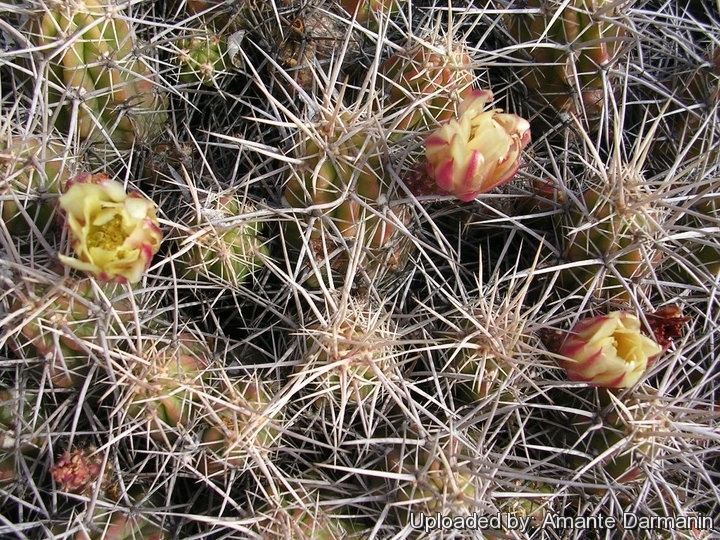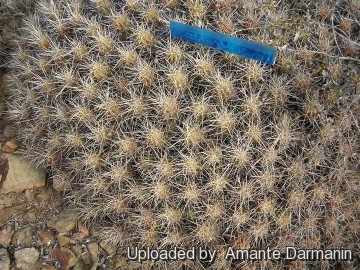
Echinocereus maritimus Photo by: Amante Darmanin
Blooming habit at Ensenada, Baja California North. Mexico.
Origin and Habitat: Echinocereus maritimusSN|8323]]SN|8323]] is endemic to the western coast of Baja California, Mexico, and adjacent islands (Extent of occurrence of 12,000 km2).
Type locality: Ensenada, Lower California.
Altitude range: 0 to 50 metres above sea level.
Habitat and Ecology: The species occurs in littoral sand dunes and on rocks a few kilometres in land, mostly at low elevations. It grows in shrub desert and in flat sedimentary hills near coast in stony-loamy soil and sandy loamy terrain in coastal areas together with locally endemic succulents such as cliff spurge (Euphorbia misera) and Agave sebastiana; and a number of cacti (Bergerocactus emoryiSN|5475]]SN|5475]], Echinocereus maritimusSN|8323]]SN|8323]], Lophocereus schottiiSN|8344]]SN|8344]], Myrtillocactus cochalSN|7812]]SN|7812]], Ferocactus fordiiSN|12330]]SN|12330]], Opuntia prolifera, Cochemiea pondiiSN|9642]]SN|9642]], Mammillaria brandegeeiSN|5426]]SN|23737]], and Mammillaria louisaeSN|23737]]SN|5426]]). The major threat for this species is urban development in the coastal area in the form of fish camps which consist of informal temporary settlements of fishermen that leave a lot of rubbish behind and they also open access paths that give way to further development and impacts such as tourism disturbance. Agriculture also affects the species, mainly tomato plantations. The production of alternative sources of energy, from tides poses a threat. Even though the species occurs within protected areas the threats in most of its range will not cease in the near future.
Synonyms:
See all synonyms of Echinocereus maritimus
Description: Echinoceres maritimus is a much branched, mounding cactus, forming colonies of cylindrical stems to 30(-40) cm high and 0.6-2 m wide with as many as 20(-300) stems (joints). In spring it displays its clear yellow flowers to the sun, but hides them from the moon. Echinoceres maritimus is variable throughout its range. The population on Natividad Island is sparsely spined and small, while a very robust and heavily armed form, which was described as Echinocereus hancockiiSN|21831]]SN|21833]] (Echinocereus maritimus subs. hancockiiSN|21833]]SN|21831]]), occurs at San Hipolito Bay. Giant forms occur also on Cedros Island.
Stems: Individual joints globose to cylindrical, light to dark green, 5-16(-30) cm high, 2,5-7 cm in diameter.
Ribs: 8-10 (or more), acute.
Areoles: 10 to 12 mm apart.
Spines: Bright red when yong, becoming dirty yellow or or horn colour fading
to grey. Central or upper spines 4 (or more), stout, strongly flattened and angled, erect, 2.5-6 cm long. Radial or lower spines, spreading, 7-10, 1.5-5 cm long.
Flowers: Small, arising below the stem tips, funnelform, light to bright yellow, including the ovary 3-4(-6) cm long and in diameter, usually not opening broadly because of interlaced spines of the plant. Inner perianth-segments oblanceolate, rounded at apex; ovary not very spiny.
Blooming season: The plants blossom occasionally over a long flowering season from spring to autumn ( in habitat April through November, with a peak in May)
Fruits: Globose, green, becoming red, spiny, about 3 cm. in diameter.
Subspecies, varieties, forms and cultivars of plants belonging to the Echinocereus maritimus group
 Echinocereus maritimus (M. E. Jones) K.Schum.: (subsp. maritimus) (regarded by N.P. TAYLOR as only a giant form of Echinocereus maritimus) is characterized by much larger heavily-spined stems that are 5,5 to 7 cm thick. It forms smaller clumps of up to 30 heads. The color of the spines of 'hancockii' varies from light yellow to black-brown, while young spination in the apex is red in color
Echinocereus maritimus (M. E. Jones) K.Schum.: (subsp. maritimus) (regarded by N.P. TAYLOR as only a giant form of Echinocereus maritimus) is characterized by much larger heavily-spined stems that are 5,5 to 7 cm thick. It forms smaller clumps of up to 30 heads. The color of the spines of 'hancockii' varies from light yellow to black-brown, while young spination in the apex is red in color Echinocereus maritimus subs. hancockii (E.Y.Dawson) W.Blum & Rutow: It grows in great clusters up to over 2 m wide, with hundreds of small short spined stems that are 4 to 7 cm thick.
Echinocereus maritimus subs. hancockii (E.Y.Dawson) W.Blum & Rutow: It grows in great clusters up to over 2 m wide, with hundreds of small short spined stems that are 4 to 7 cm thick.
Bibliography: Major references and further lectures
1) Edward Anderson “The Cactus family” Timber Press, Incorporated, 2001
2) Nathaniel Lord Britton, Joseph Nelson Rose “Cactaceae: Descriptions and Illustrations of Plants of the Cactus Family” Volume 3, 1922
3) León de la Luz, J.L., Gómez-Hinostrosa, C. & Hernández, H.M. 2013. Echinocereus maritimus. The IUCN Red List of Threatened Species 2013: e.T152134A601105. http://dx.doi.org/10.2305/IUCN.UK.2013-1.RLTS.T152134A601105.en. Downloaded on 21 February 2017.
4) Forrest Shreve, Ira Loren Wiggins “Vegetation and Flora of the Sonoran Desert”, Volume 1 Stanford University Press, 1964
5) Carsten Hobohm “Endemism in Vascular Plants” Springer Science & Business Media, 23 August 2013
6) Grady Linder Webster, Conrad J. Bahre “Changing Plant Life of La Frontera: Observations on Vegetation in the United States/Mexico Borderlands” UNM Press, 2001
7) George Edmund Lindsay “The taxonomy and ecology of the genus Ferocactus” Dept. of Biological Sciences, 1955
8) Blum, W.; Lange, M.; Rischer, W. & Rutow, J “Echinocereus” Selbstverlag, Aachen 1998
9) Taylor, N. “The Genus Echinocereus” Royal Botanic Gardens Kew 1985
10) IUCN. 2013. “IUCN Red List of Threatened Species” (ver. 2013.1). Available at: http://www.iucnredlist.org. (Accessed: 12 June 2013).
11) Peinado, M., Alcaraz, F., Aguirre, J.L., and Delgadillo, J. “Major Plant Communities of Warm North American Deserts”. Journal of Vegetation Science 6(1): 79-94.1995.
12) Paul Hoxey “Flowering Echinocereus hancockii in the glasshouse” pp 13-15, Number 7 February 2013 ISSN 2048-0482 The Cactus Explorer
 Echinocereus maritimus, in habitat at Ensenada, Baja California North, Mexico. Photo by: Amante Darmanin
Echinocereus maritimus, in habitat at Ensenada, Baja California North, Mexico. Photo by: Amante DarmaninSend a photo of this plant.The gallery now contains thousands of pictures, however it is possible to do even more. We are, of course, seeking photos of species not yet shown in the gallery but not only that, we are also looking for better pictures than those already present.
Read More... Cultivation and Propagation: This plant from Baja California needs warmer winter temperatures, and can resist only occasional light frost, above -2 C. It is sensitive to over-watering (rot prone) and needs good drainage. Fertilize with a half-strength liquid fertilizer in summer. Keep absolutely dry in winter. Needs full sun;
Propagation: Seeds or cutting (if available)












